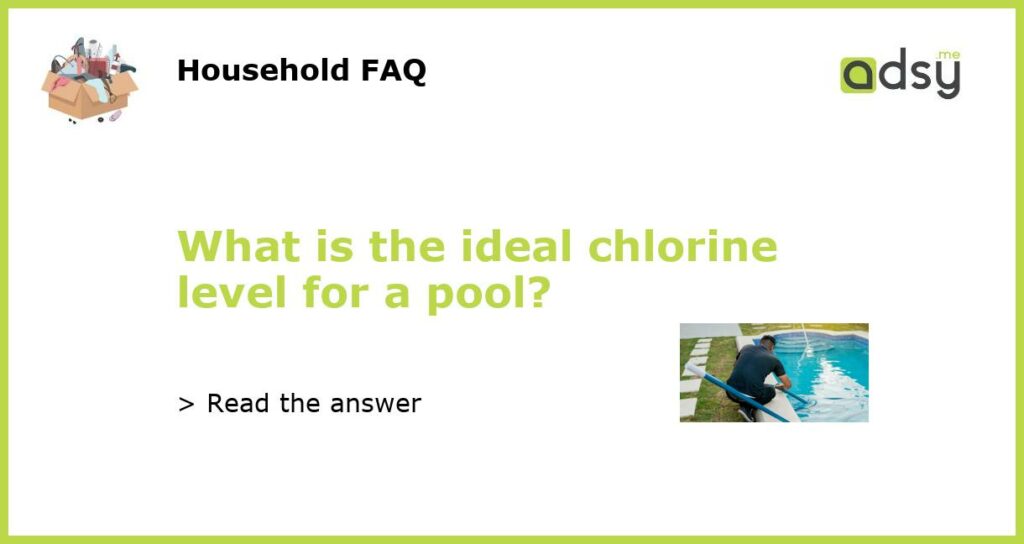Understanding the Ideal Chlorine Level for Your Pool
When it comes to maintaining your pool, one of the most important factors to consider is the chlorine level. Chlorine plays a vital role in keeping your pool water clean and free from harmful bacteria. But what is the ideal chlorine level for a pool? In this article, we will explore the recommended chlorine levels and why they are important for maintaining a safe and healthy swimming environment.
What is Chlorine and Why is it Important?
Chlorine is a chemical compound commonly used as a disinfectant in pools and other water sources. It is highly effective in killing harmful bacteria, viruses, and other pathogens that can cause diseases. Chlorine also helps to control algae growth and oxidize organic matter such as sweat and sunscreen that can contaminate the water.
Without chlorine, the water in your pool can quickly become a breeding ground for bacteria and other microorganisms. This can lead to various issues such as skin infections, eye irritation, and even gastrointestinal illnesses. Therefore, maintaining the right chlorine level is crucial for ensuring the safety and cleanliness of your pool.
Recommended Chlorine Levels
The ideal chlorine level for a pool typically falls within a range of 1.0 to 3.0 parts per million (ppm). This range is considered the optimal level for both ensuring effective disinfection and minimizing any potential side effects of chlorine exposure.
It is important to note that the recommended chlorine level can vary depending on factors such as the type of pool (e.g., indoor or outdoor), the pool’s size and water volume, and the weather conditions. For example, outdoor pools exposed to direct sunlight may require slightly higher chlorine levels to compensate for chlorine loss due to UV degradation.
Testing and Adjusting Chlorine Levels
To determine the current chlorine level in your pool, you can use a chlorine testing kit or strips. These kits typically measure the level of free chlorine, which is the amount of chlorine available for disinfection.
If the test results indicate that the chlorine level is below the recommended range, you will need to add chlorine to your pool. There are various products available for this, including chlorine tablets, granules, or liquid chlorine. It is essential to follow the manufacturer’s instructions and guidelines when adding chlorine to your pool to avoid over-dosing or under-dosing.
On the other hand, if the chlorine level is too high, you may need to dilute the pool water by adding fresh water or using a pool water conditioner. High chlorine levels can cause skin and eye irritation and also degrade the pool equipment over time.
Other Factors Affecting Chlorine Levels
In addition to regular testing and adjustment, several other factors can impact the chlorine levels in your pool. These include:
pH Level: The pH level of your pool water can influence the effectiveness of chlorine. Ideally, the pH should be between 7.2 and 7.8, as this range allows chlorine to work most efficiently.
Water Temperature: Warmer water tends to evaporate chlorine faster, so it may require more frequent monitoring and adjustment.
Pool Usage: The number of swimmers and the frequency of use can impact chlorine demand. Pools with heavy usage may require more chlorine to maintain the ideal level.
Importance of Regular Maintenance
Maintaining the ideal chlorine level is just one aspect of pool maintenance. Regular maintenance tasks such as cleaning the pool, checking the filtration system, and balancing the water chemistry are also crucial for optimum pool health.
Regularly checking and adjusting the chlorine level will not only keep your pool water clean and safe but also extend the lifespan of your pool equipment. It is recommended to test the chlorine level at least once a week, or more frequently during periods of heavy pool usage or extreme weather conditions.
In conclusion, the ideal chlorine level for a pool falls within a range of 1.0 to 3.0 ppm. Maintaining this level is crucial for preventing the growth of harmful bacteria and ensuring a safe and healthy swimming environment. Regular testing, adjustment, and proper pool maintenance are essential for achieving and maintaining the recommended chlorine level.

